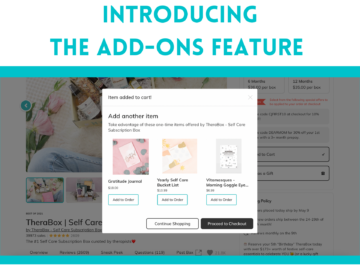Welcome to Cratejoy’s Subscription Box Pricing Guide. In this guide we’ll be walking through important information to know about pricing and important financial considerations surrounding your subscription box business.
Table of Contents:
Understanding Your Margins
Regardless of where you are in your business journey, you need to regularly re-evaluate your margins. Many subscription box sellers do so at the beginning of the year as part of a yearly assessment of the state of their business.
How to Find Your Margins
So how do you calculate your margin?
Your gross margin is how much money you make per box after you have subtracted:
- Cost of all items that go in your box
- Cost of all items that make up your box (printing, confetting packing material, etc)
- Cost of labor to deliver your box (shipping)
Your net margin is how much money you make per box after you have subtracted:
- All additional costs that are not considered COGS (cost of goods sold) such as:
- Software subscriptions
- Employee payroll
Increase Your Margins
After determining your margin you most likely will want to increase it. A margin should be something that grows consistently. Often subscription box businesses do not see an increase from their original margins until they start to scale. Want to start scaling your business? We can help!
This is why it is so important to consider what your margin will be at the very beginning of your subscription box business journey. If the margin is too high: awesome (as long as you are getting sales)! But this also may mean you are pricing some customers out and they may not buy your products. If the margin is too low: you may not have the revenue you need to take the next step.
When planning an increase to your margins you should focus on making an attainable and clear goal for your business. The team at Cratejoy really likes using the SMART (Specific – Measurable – Attainable – Relevant – Time Bound) goal-setting system and encourages you to do the same.
As you are reevaluating your margins: make sure you are sourcing the right products for your box.
How to Source the Right Products for Your Subscription Box
We often stress the importance of having a high-quality listing and how that translates to more sales. Having an awesome listing and getting the sale is key, but now you need the product to back it up.
Putting low-quality products, or products that don’t match the expectation of the customer, in your box will result in cancellations (churn) and, possibly, negative feedback.
When sourcing your product, ask yourself these 3 questions:
- Does it fit your budget?
- Does it make sense for your theme?
- Will a customer be delighted to receive it?
If your answer is no to any of these questions, keep searching for the right product.
Also, since you are running a subscription box and will continue to need products to fill up future boxes, keep track of where you get your highest-performing products. Monitor emails and reviews to see what gets mentioned as a high value or unique item that was fun to receive. Reading reviews of other subscription boxes in your niche can also give you insight into which products to include or avoid.
Want some ideas on where to start looking for products? We’ve put together a list for you.
Thoughtful product curation and attention to what your target audience finds valuable is the foundation of a great subscription box business.
Shipping Costs
One of the most important considerations when selling a subscription box is the cost of shipping. Shipping costs will never be static, but will always be increasing.
Plan for Shipping Cost Increases
When deciding whether to offer free shipping or not, consider this: if you offer free shipping you will have to increase the price of the box to cover shipping cost increases. If you charge for shipping: you can simply increase the cost of shipping.
There are a few methods to consider before passing on increased costs of shipping to your customers.
Compare Shipping Costs from Providers
Besides your product, shipping may be your biggest expense. There are many shipping vendors and delivery partners to choose from when selecting the right fit for your business.
As you grow your business you will find that shipping more often means saving more on shipping rates. Reevaluate your shipping and delivery vendor relationships frequently to get the most out of your spend.
If you’re just starting out, PirateShip is a free app that integrates with Cratejoy and helps you get the lowest rates on USPS. (Read more about the apps that integrate with Cratejoy.)
Packaging
Another important factor that impacts your margins and costs of doing business is packaging. It is crucial to understand the weight and sizing of your shipments.
Some cost-saving ideas for packaging:
1. Create product combinations with a weight cut-off in mind
2. Evaluate the kind of cushioning material that will be used to protect items
3. Consider rigid vs. non-rigid packaging (only applies to some products)
Differentiate yourself from the competition by offering unique experiences through your products and retaining your subscribers through excellent customer service.
Setting & Updating Pricing
Whether you are reading this because you need to set an initial price or you need to update an existing price, remember this: do your research!
- Who is your customer?
- What other offerings are in your niche?
- What sets you apart from those other offerings?
- Are you selling an experience, a replenishment product, or a curation?
- Is your business focused on providing value or a premium service?
While evaluating your price keep this in mind: pricing is not a race to the bottom. Being the cheapest offering in a certain category does not necessarily equal more customers or sales. Rather focus on understanding value perceptions, delivering the right experience, and understanding your competition.
Understanding Value Perceptions
The value perception of your products, and the overall experience you are delivering to your customers, goes hand-in-hand with your product curation efforts.
Value perception is not just about the monetary value of your products (although this can be important!). Here are some examples of what a potential subscriber may perceive as valuable:
- Ability to source unique or hard-to-find products
- Relationships with local makers, vendors, or artisans as suppliers
- Environmentally-friendly product sourcing, packaging, and shipping
- Access to subscriber-only perks and community groups
Once you have identified the value perception of your offerings, you can work to maintain or improve your curation process and customer experience. Meeting or exceeding your customers’ expectations will reduce churn and generate more sales.
Delivering the Right Experience
Subscription box subscribers are in some ways different from a typical online shopper. They are searching for a product, but they are also searching for, and find value in, an experience.
The motivation to buy a subscription (or gift one!) can vary widely. A subscriber may be motivated by the convenience of not having to search for items or the adventure of not knowing what they get each month.
That experience includes (but is not limited to!):
- A well-written listing that clearly details contents and shipping information
- Customer service and prompt responses to messages, questions, and reviews
- Thoughtful and well-designed packaging
- Quality products that live up to the description and deliver the intended experience
- Engaging follow up (such as a renewal coupon code in their last shipment)
Lots of work goes into starting and maintaining a subscription box business, so set yourself up for success by regularly evaluating the experience that you are offering and making adjustments as needed.
Understanding Competition
One of the first considerations when launching a subscription box business is understanding competition. There may be other subscription boxes or services that are similar to your idea. Researching other companies in your niche will yield important information about:
- Target audience
- Desirable product
- Blindspots or pain points (make sure to read reviews!)
Build your box in a way that differentiates your product and service from your competitors. Remember though, this is not a race to the bottom in terms of how to price your box. Customers are often willing to pay more for better quality, service, or value.
There can be an instinct to do something truly unique that no one else is offering. If you are finding that there are no competitors for your product, do a little digging to find out more. If it is an idea that truly no one has attempted: find out why!
Additional Financial Strategies
Buy in Bulk
If you can purchase something in large quantities that does not compromise the value perception of your box: buy it in bulk.
Packing materials, customized boxes, and custom box inserts are all great items to buy in larger quantities (pending your overall number of active subscribers).
When considering whether to buy in bulk or not: evaluate your number of subscribers and your churn rate.
Find New Vendors
The items in your box are, typically, your most costly business expense.
Creating and maintaining relationships with vendors that can provide the items you need, at a cost that makes sense for your business, is crucial. Finding new vendors also keeps your box fresh and your customers enthused about receiving it regularly.
Manage Your Cash Flow
One unique aspect of being a subscription box seller is that you often receive money upfront for shipments that will go out well into the future.
Example: a subscriber pays $600 for a monthly, year-long subscription to your box. You received the $600 in January and you owe the subscriber shipments until December. While you did receive the $600 all at one time, it is best to “recognize” $50 a month in order to cover all associated costs of getting the box ready and shipped to the customer.
Read more about cash vs accrual accounting for subscription boxes here.
Growing your business takes effort and consistency. We’re here to help you every step of the way! Schedule regular check-ins with your business to see where you can save money and increase your margin. Also, consider registering for one of Cratejoy’s seller webinars or watching recordings of past webinars here.
Want to keep reading? We think you’ll benefit from this blog post about how to source subscription box products.



